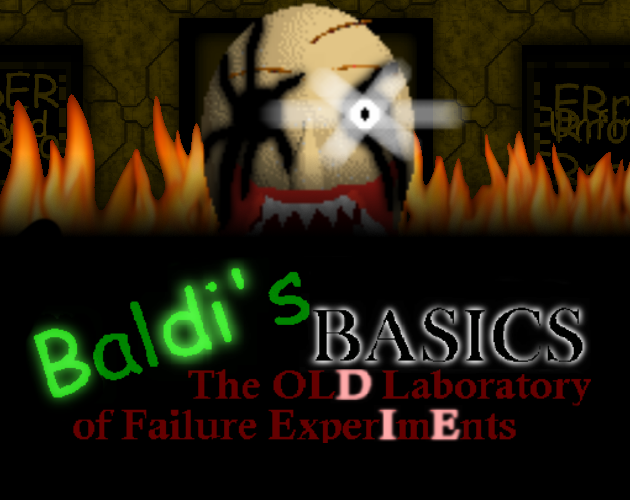1. What is FreeNAS?
- Baldi's Basic Swapped The Old Laboratory Mac Os Version
- Baldi's Basic Swapped The Old Laboratory Mac Os Download
- Baldi's Basic Swapped The Old Laboratory Mac Os X

2. Why would I use FreeNAS?
Game description: Have you ever thought that your math teacher might be a bit strange? Well, if you are Baldi's students, then you are definitely right! This guy is a real disaster and you will definitely have hard time at his school. When you visited the class, Baldi asked you to solve a math problem, but you realized that.
3. What do I need to get started with FreeNAS?
Memory christmas mac os. To use FreeNAS, you'll need standard PC hardware with a 64-bit processor and at least 8GB of RAM. The FreeNAS® operating system is installed to at least one device that is separate from the storage disks. The Operating System Device can be an SSD, a small hard drive, or a USB stick. We recommend a minimum size of 8GB. A device with 16GB or more provides additional room for boot environments.
- Hello Dare Baldi Swapped. Available for Windows, macOS. Baldi's Basic Swapped The Old Laboratory. A downloadable game for Windows and macOS. More information.
- For iOS, Android ™, Windows ®, and Mac ®. Flexibility to upload your own designs. Use your own images and fonts in a variety of standard file formats. 50 ready-to-make projects. Includes 25 digital sewing patterns plus more projects that demonstrate what Cricut Maker can do. Adaptive Tool System for cutting hundreds of materials.
- Baldi's Evil Basics Scratch Edition V0.01 BETA remix by Jpgaming76; Baldi.EXE broken and even more cursed by DarktowerRising; Baldi's Basics in Education and Learning by jboom25; Pugsley's Basics in Pugs & A Bit of Math by Th3DerpyPug; Baldi's Basics Scratch Edition V0.01 BETA remix by scratchgameing4574.
- ArcaOS is a 32-bit OS that runs on the x86 processor architecture, so should be compatible with some particularly old PCs. Though its native file system is JFS, it ships with drivers for the FAT32.
To get started with FreeNAS, write the installation file to the Install Media, typically a USB drive. Keep in mind there are two separate devices, the Operating System Device and the Install Media. One device contains the install media, while the other will contain the FreeNAS Operating System after installation. Be careful to select the correct device during installation. FreeNAS cannot be installed onto the same device that contains the installer. After installation, remove the Install Media Device. It might also be necessary to adjust the BIOS configuration to boot from the new FreeNAS operating system device. Once you start your FreeNAS system for the first time you should be provided with an IP address after boot. Point your web browser at the IP address of the FreeNAS system from any computer with a web browser on the network and you're good to go! Read the FreeNAS Documentation for more information.
Baldi's Basic Swapped The Old Laboratory Mac Os Version
4. Is FreeNAS Safe and Secure?
5. What else can I do with FreeNAS?
6. Can FreeNAS be used as a Media Server?
7. Why does FreeNAS only support the ZFS filesystem?
8. How do I upgrade FreeNAS?
9. Where can I get help with FreeNAS?
10. What if I don't want to build my own hardware for FreeNAS?
Baldi's Basic Swapped The Old Laboratory Mac Os Download
11. Why is FreeNAS 64-bit only?
12. What are the hardware requirements for FreeNAS?
13. Can I downgrade from FreeNAS Corral to FreeNAS 9.10?
Baldi's Basic Swapped The Old Laboratory Mac Os X
If you initially upgraded from FreeNAS 9.10 to FreeNAS Corral, reboot the system, highlight 'Boot Environment Menu' from the boot menu, and select the previous 9.10 installation from the boot menu. This will instruct the system to return to FreeNAS 9.10 and its configuration. You can then use System -> Boot to permanently set the FreeNAS 9.10 entry as the default.
Note that the initial upgrade to FreeNAS Corral migrated the 9.10 configuration into the FreeNAS Corral configuration format. The FreeNAS Corral configuration file format is different from a FreeNAS 9.10 configuration. This means that you should not attempt to restore a configuration that was saved on FreeNAS Corral while booted into FreeNAS 9.10.
If you upgraded your pool using FreeNAS Corral, you may receive an error when FreeNAS 9.10 tries to mount the pool. If you need assistance resolving any boot errors, please create a post on the FreeNAS Forums.

